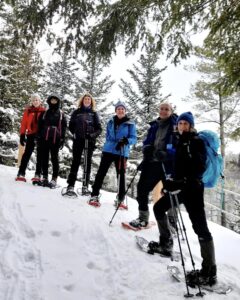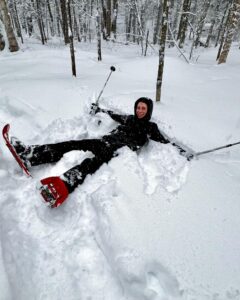Let yourself go, try snowshoeing with RA!About snowshoeingIndigenous peoples in Canada and elsewhere made their own snowshoes and used them to get about in winter. Then, early settlers adopted this form of transportation. In the early 1900s people started using snowshoes for sport and it became quite popular. By the latter half of the 20th century, snowshoeing gave way to other winter activities and became less common. However in the past several years, outdoor enthusiasts have rediscovered the joys of walking in the woods in the winter, and with new materials and innovative designs, snowshoeing has been reborn! You’ll love itThere is really nothing technical to it – if you can walk, you can snowshoe. You don’t have to be super fit or fast, it’s up to you to choose the level of effort you put into it. Enjoy getting out for fresh winter air, walking on picturesque trails cut through forests heavily laden with beautiful white snow! The peace and quiet of the winter forest, friendly birds looking for treats and fabulous winter scenery will be yours when you join your RA companions on one of our snowshoe outings. Modern equipment
You should have comfortable low-heel winter boots which will fit right into the harness attached to the snowshoes. On milder days you can even use hiking boots for snowshoeing. In addition to snowshoes, we highly recommend getting Microspikes or snow crampons (from specialized outdoor stores -not the crampons you use in the city) to wear on your boots when trails are icy and hardpacked. Ski poles or hiking poles are also recommended to help with the undulating terrain! |
What to bring, what to wearYou’ll need to dress in layers. Wear a hat, scarf, and mitts, as usual. Gaiters are a great help in keeping deep snow from entering the tops of your boots and making your socks wet. Check the Cross-country Skiing Tips page for additional tips on clothing. Bring a change of clothes
Buy a snowshoe bagA bag will protect your snowshoes and make it easier to load them on the bus and to carry them on the Metro. Please identify your bag clearly with a piece of contrasting fabric with your name on it tied to the outside of the bag, or write your name clearly on the bag. If you do not have a bag, then your snowshoes should be strapped together securely and labelled with your name. On the TrailsDon’t forget some seeds and nuts to feed the birds. Most of all, bring an open spirit and enthusiasm for enjoying the great outdoors! Be sure to consult our On the Trails page for more useful advice. |


